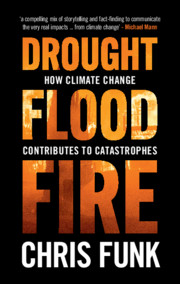Book contents
- Drought, Flood, Fire
- Drought, Flood, Fire
- Copyright page
- Contents
- Acknowledgments
- 1 Climate Extremes, Climate Attribution, Extreme Event Attribution
- 2 Welcome to an Awesome Planet
- 3 The Earth Is a Negentropic System, or “the Bright Side of Empty”
- 4 Do-It-Yourself Climate Change Science
- 5 Temperature Extremes – Impacts and Attribution
- 6 Precipitation Extremes
- 7 Hurricanes, Cyclones, and Typhoons
- 8 Conceptual Models of Climate Change and Prediction, and How They Relate to Floods and Fires
- 9 Climate Change Made the 2015–2016 El Niño More Extreme
- 10 Bigger La Niñas and the East African Climate Paradox
- 11 Fire and Drought in the Western United States
- 12 Fire and Australia’s Black Summer
- 13 Driving toward +4°C on a Dixie® Cup Planet
- 14 We Can Afford to Wear a White Hat
- Appendix A Few Resources for Further Reading and Research
- Index
3 - The Earth Is a Negentropic System, or “the Bright Side of Empty”
Published online by Cambridge University Press: 01 June 2021
- Drought, Flood, Fire
- Drought, Flood, Fire
- Copyright page
- Contents
- Acknowledgments
- 1 Climate Extremes, Climate Attribution, Extreme Event Attribution
- 2 Welcome to an Awesome Planet
- 3 The Earth Is a Negentropic System, or “the Bright Side of Empty”
- 4 Do-It-Yourself Climate Change Science
- 5 Temperature Extremes – Impacts and Attribution
- 6 Precipitation Extremes
- 7 Hurricanes, Cyclones, and Typhoons
- 8 Conceptual Models of Climate Change and Prediction, and How They Relate to Floods and Fires
- 9 Climate Change Made the 2015–2016 El Niño More Extreme
- 10 Bigger La Niñas and the East African Climate Paradox
- 11 Fire and Drought in the Western United States
- 12 Fire and Australia’s Black Summer
- 13 Driving toward +4°C on a Dixie® Cup Planet
- 14 We Can Afford to Wear a White Hat
- Appendix A Few Resources for Further Reading and Research
- Index
Summary
Here, framed in the context of a humorous story, we learn about the electromagnetic spectrum, entropy, negentropy, and available potential energy. We learn to see stars as tremendous gravity-driven concentrations of matter and energy, uniquely capable of supporting increased complexity and life on our planet. Seen from this perspective, the vast empty reaches of space allow for the formation of stars, which in turn support life. Energetically closed systems are doomed to entropic heat death, as mixing drives the system inexorably toward a boring end. But energetically open systems, like the Earth, absorb solar radiation and turn it into growing complexity on a planet hovering in a “magic” and narrow temperature range. This “negentropic” system can evolve over time. This increasing complexity arises because this incoming energy supports temperature gradients that drive weather and climate systems. Climate change adds more energy, and this extra energy can create more intense gradients, and more intense weather and climate events. Understanding this simple fact improves our ability to recognize and predict the dangerous impacts occurring now. At large scales, exceptionally warm tropical waters drive drought-inducing semi-global rainfall disruptions. At regional scales, warmer Ocean and atmosphere conditions can lead to more intense storms and hurricanes. As more energy moves through our Earth system, we are experiencing more extreme weather and climate.
Keywords
- Type
- Chapter
- Information
- Drought, Flood, FireHow Climate Change Contributes to Catastrophes, pp. 40 - 58Publisher: Cambridge University PressPrint publication year: 2021

